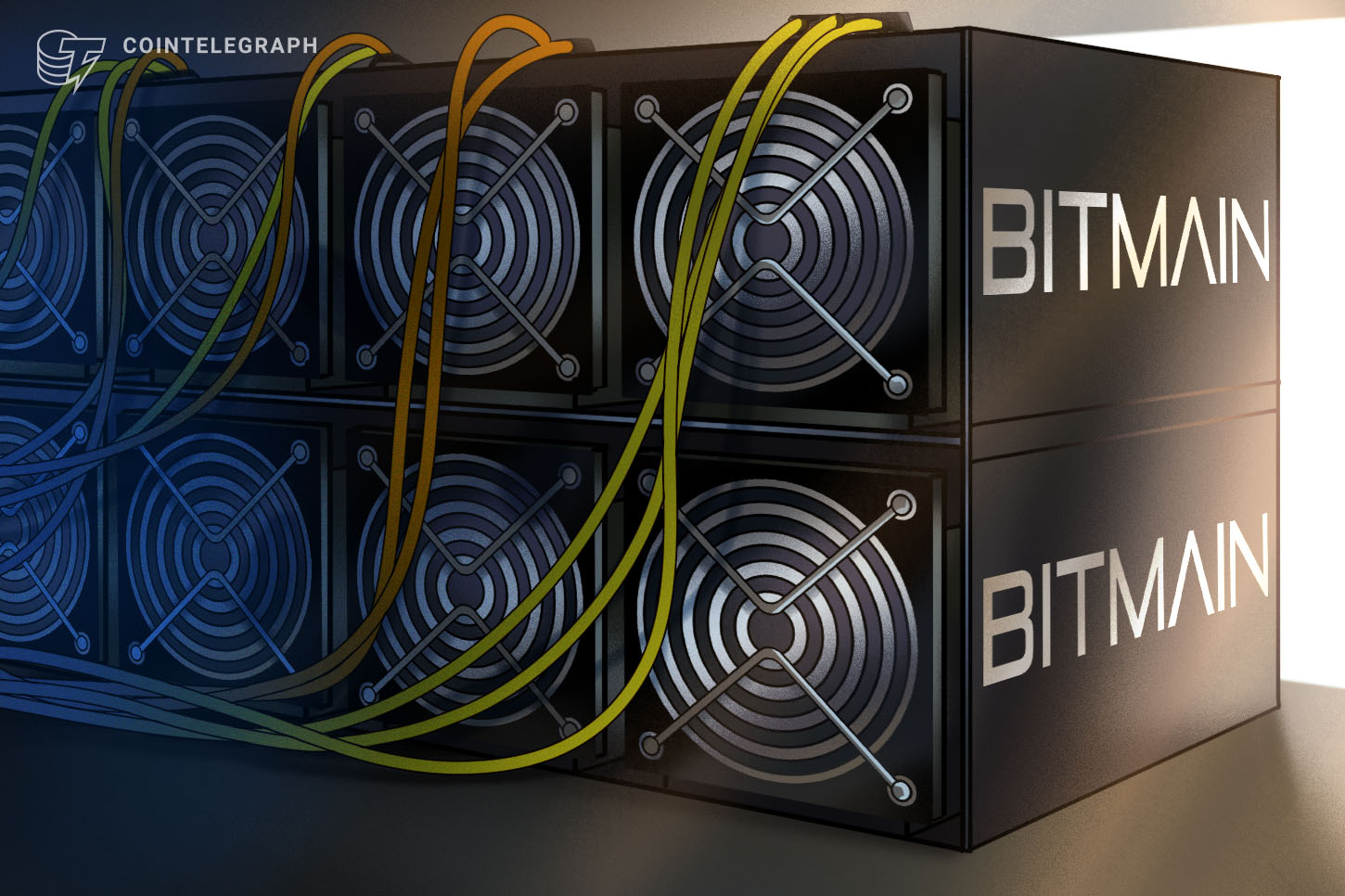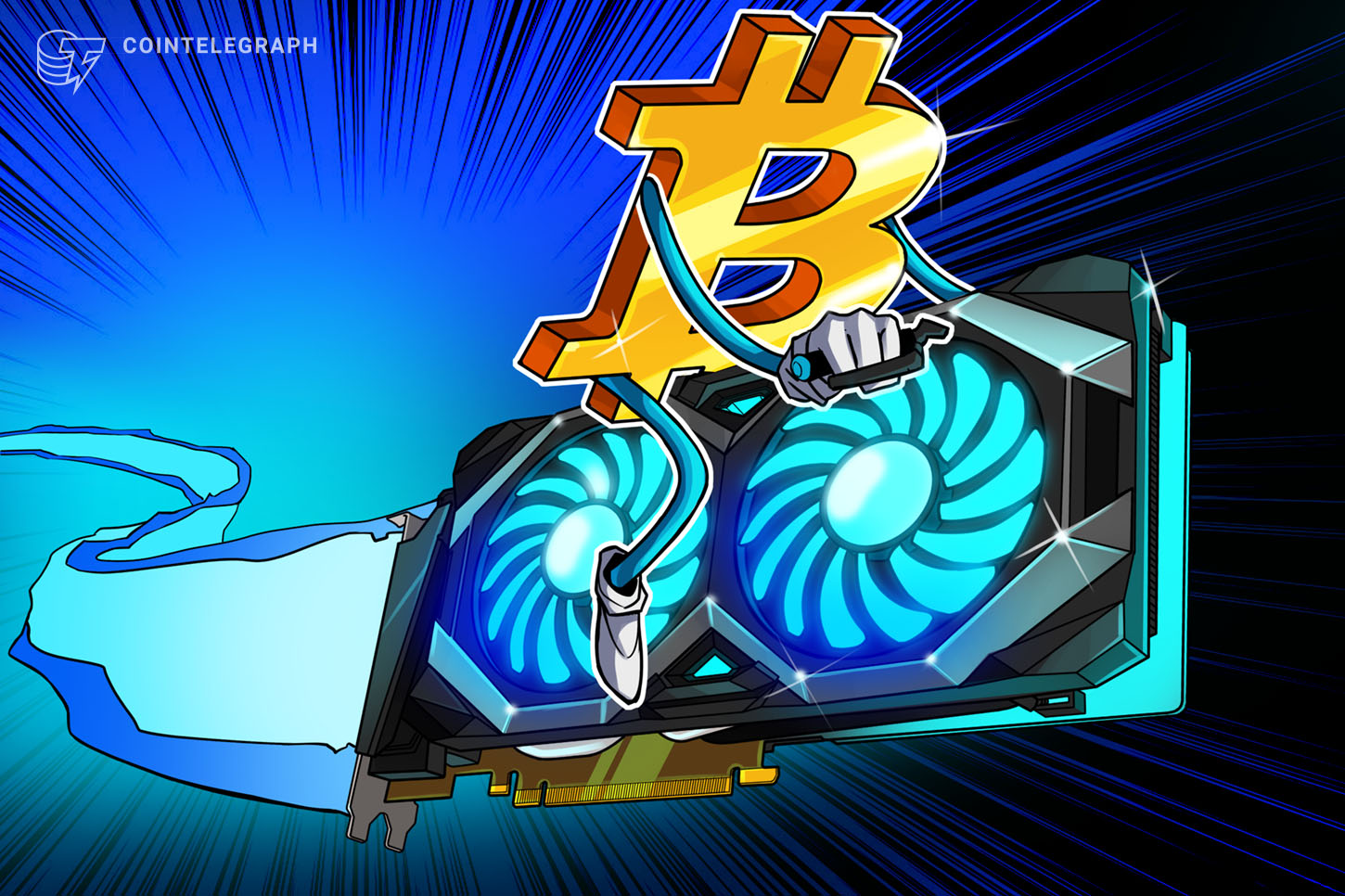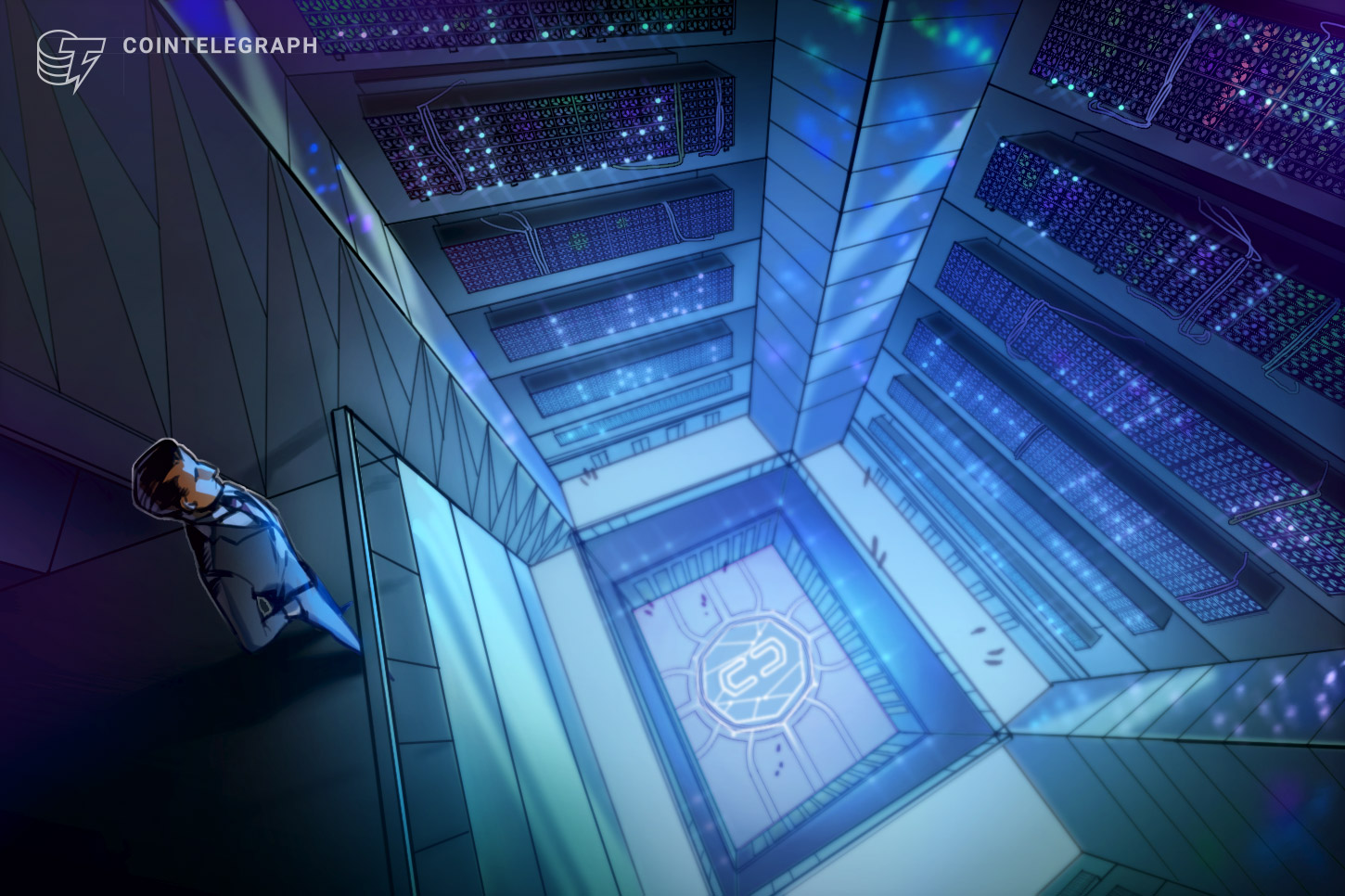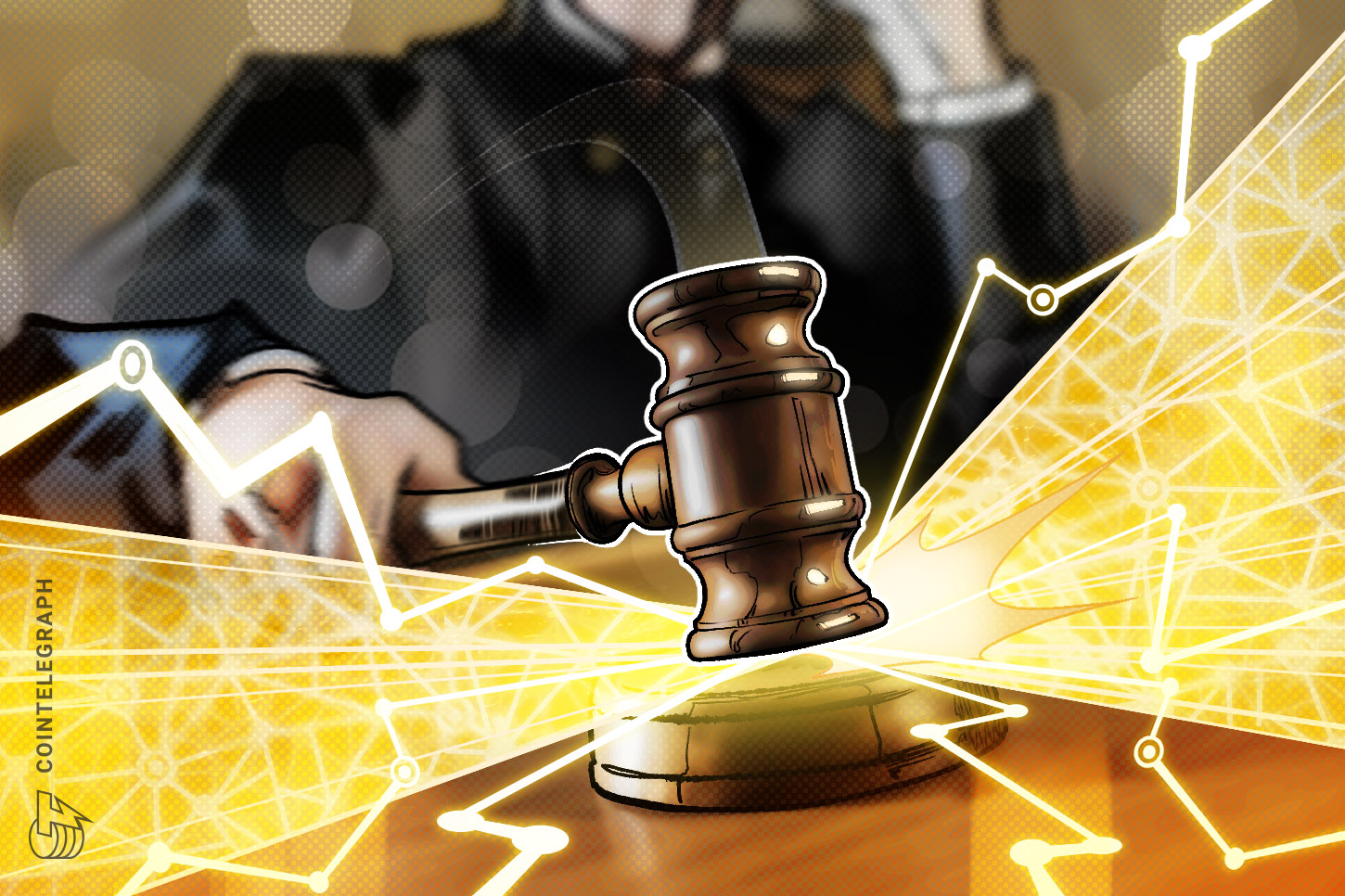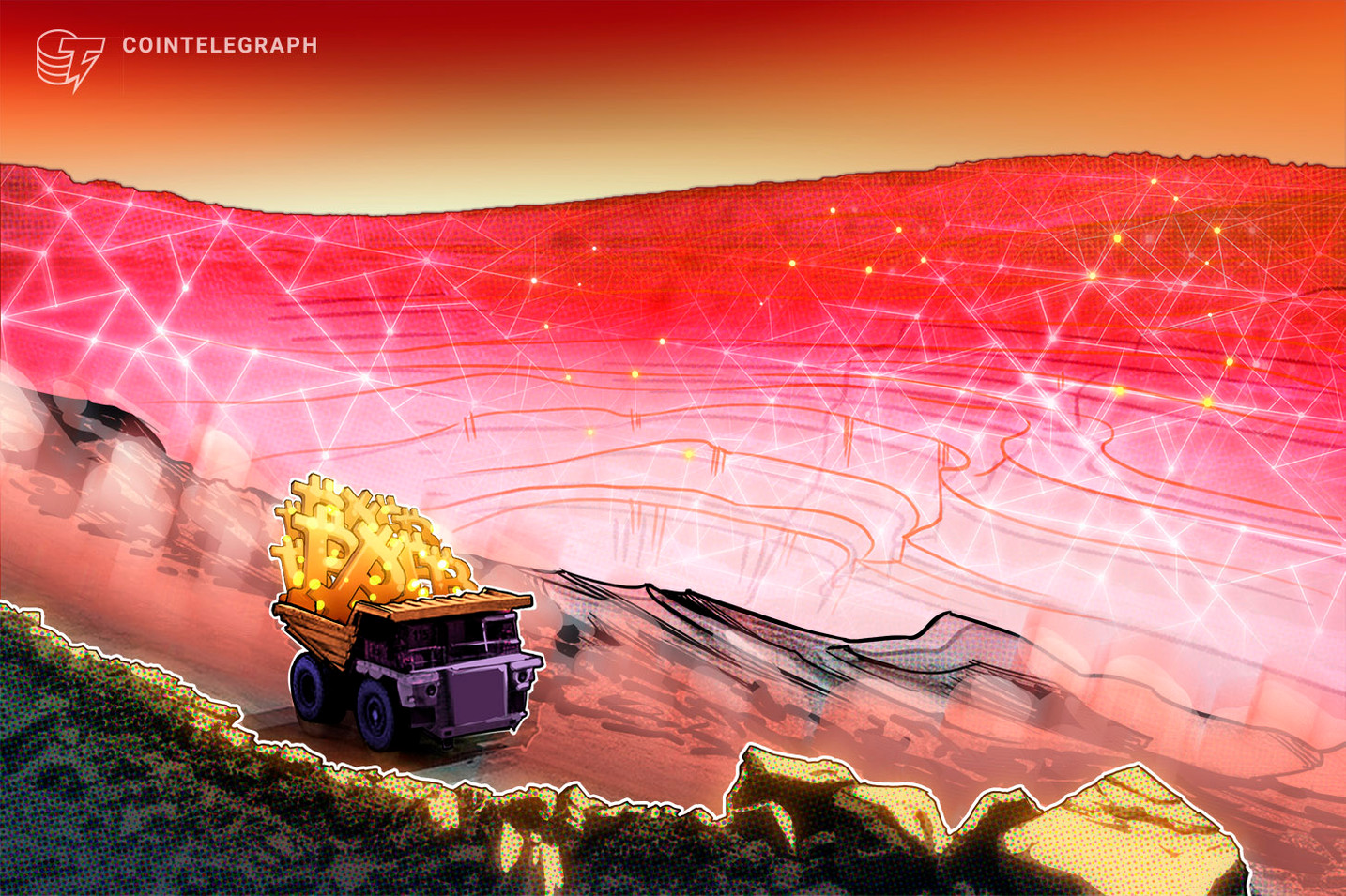The discount coupons issued last year haven’t been used because miners don’t have the cash to spend on new equipment.
CleanSpark boosts computing power by 37% with thousands of new Bitmain rigs

The Bitcoin miner announced the purchase of 20,000 new Antminer S19j Pro+ at a 25% discount, approximately $13.25 per terahash.
Celsius bankruptcy judge authorizes the sale of $7.4M worth of Bitmain coupons

The judge’s ruling does not require Celsius debtors to sell the Bitmain coupons, but they would need the consent of the committee of unsecured creditors.
Judge Clears Celsius’ Plan to Sell Bitmain Mining Coupons Worth Over $7M
The crypto lender must sell the vouchers before they expire, to raise funds for the bankruptcy estate
Iris Energy to nearly triple hash rate with estimated 44,000 new BTC miners

With the tough conditions that faced Bitcoin miners last year, Iris’ co-founder said the purchase was a “significant milestone” for the company.
Cloud mining firm BitFuFu postpones merger with SPAC until May

Bitfufu’s plans to go public have been delayed for the second time. The company is the cloud mining arm of Chinese mining giant Bitmain.
Rumor has it that Dogecoin could shift to proof-of-stake — What does that mean for miners?

Dogecoin shifting to proof-of-stake would be good for the environment, but what impact would it have on miners and ASIC manufacturers?
Core Scientific files motion to sell over $6M in Bitmain coupons

Some conditions applied to the coupons make them useless for Core Scientific’s business, a court filing shows.
Crypto lender Matrixport seeks $100M funding despite lending crisis

Bitmain-backed crypto lender Matrixport is the other half of a new funding round targeting a $100 million raise.
Bitcoin mining firm Bitdeer could delay public offering to 2023

An SEC filing stated Safari Group shareholders could vote to give the company the option to extend the Bitdeer deadline up to four times until December 2023.
Old Bitcoin mining rigs risk ‘shutdown’ after BTC price slips under $24K

New generation Bitcoin mining machines would remain profitable even if the BTC price crashes by another 50%.
Bitmain Rolls Out More Powerful And Energy-Efficient Bitcoin Mining Rig To Date
Liquid-cooled mining machines from Chinese chipmaker Bitmain have been unveiled.
The S19 XP HYD is expected to be one of the company’s most energy-efficient models ever.
The new mining setup employs liquid cooling. According to reviewers, it is the most power-efficient among all models of mining equipment from this manufacturer.
These hydro cooling rigs are exclusively for usage in Bitmain containers.
Bitmain Rig Packs A Punch
The newly announced mining rig is dubbed “Antminer S19 XP Hyd.” It boasts 255 terahashes per second (TH/s) of processing power and 20.8 joules per terahash (J/T) of power efficiency while operating on 5,304 watts, according to Bitmain’s website.
The machine features a liquid cooling system, which involves using a coolant flowing through pipes to dissipate heat from the device.
The cooling rigs will launch in the first quarter of 2023 for a little under $20,000 per unit.
Related Article | Abra CEO Predicts Ethereum Could Reach $40,000 – But Some Fintech Analysts Don’t Agree
Furthermore, the energy efficiency of this new model slightly outperforms Bitmain’s previous best rig – the Antminer S19 XP.
Notably, Bitmain has also announced the release of the ANTSPACE HK3, a new bitcoin mining container that can comfortably accommodate 210 mining machines and uses up to 1 megawatt of electricity.
Aiming For Sustainable Bitcoin Mining
Bitmain has been focusing on long-term bitcoin mining and has recently unveiled measures in this area.
Bitmain will create up to 500 MW of clean digital mining infrastructure at Merkle Standard’s hydro-powered facilities in Eastern Washington as part of the joint venture.
BTC total market cap at $767.68 billion on the daily chart | Source: TradingView.com
Furthermore, the Beijing-based chipmaker has gained a significant stake in one of America’s major crypto-mining facilities via a collaboration with Allrise Capital.
The move might help Bitmain’s market expansion in the United States even further.
According to mining data, the bitcoin mining metrics have seen some intriguing developments in recent months, as the Bitcoin hashrate grew by more than 15% in a week as processing power steadily increased.
Energy Efficient Mining
Meanwhile, Block Inc.’s CEO, Jack Dorsey, revealed last October that the firm was exploring developing an open-source bitcoin mining system built on bespoke silicon to decrease entry barriers for both businesses and people.
In January, Thomas Templeton, Block’s general manager for hardware, emphasized that the planned approach would improve bitcoin mining efficiency and other benefits.
Templeton said:
“We’re interested because mining is about more than just producing new bitcoin. We regard it as a long-term need for a decentralized and permissionless future.”
In a related event, Hive Blockchain had signed an arrangement with Intel to acquire the latter’s recently introduced energy-efficient blockchain accelerators named Bonanza Mine.
Related Article | Ripple Welcomes More Than 4,000 Artists Into Its New NFT Platform
Featured image from Bitcoin News, chart from TradingView.com
Green Mining Company HIVE Secures Deal To Buy A Number Of Intel’s New ASICs
The ESG-focused mining company HIVE is the latest organization to sign a deal with Intel. It joins Block, Argo Blockchain, and GRIID, as the first clients and testers of the giant’s new ASICs. Intel’s Bonanza Mine project is quickly becoming one of bitcoin’s stories of the year. It’s funny that, so far, no one has seen the equipment. The idea of a bitcoin miner made in the US is appealing, though. Plus, the project’s rollout has been masterful so far.
The headline here is that “HIVE owns state-of-the-art, green energy-powered data centre facilities in Canada, Sweden, and Iceland, where we source only green energy to mine.” In a recent press release, the company announced the Intel deal and its intention to expand into the US. “The Company is planning for a 100 MW deployment at one of Compute North’s renewable energy campuses in Texas.”
HIVE self-proclaimed itself “the first cryptocurrency mining company with a green energy and ESG strategy”. The company’s other significant characteristic is that they’re holders. “Since the beginning of 2021, HIVE has held in secure storage the majority of its ETH and BTC coin mining rewards.” That goes in line with new data that shows that miners are quietly accumulating bitcoin as the market bleeds.
BTC price chart for 03/08/2022 on Capital.com | Source: BTC/USD on TradingView.com
What Do We Know About HIVE ‘s Deal With Intel?
Not much, really. “HIVE has entered into a Supply Agreement with Intel which is one of the world’s largest semiconductor manufacturers, for their upcoming blockchain accelerator.” Notice how HIVE calls the ASICs “blockchain accelerators,” just as Intel did in the company’s blog. Will the name catch on?
The press release doesn’t specify how many bitcoin miners will HIVE buy, but, it provides some relevant data:
“These miners are expected to be delivered over a period of one year starting in the second half of calendar 2022, the effect of which, if they are all installed, would be an expected increase of up to 95% in our aggregate Bitcoin mining hashrate from 1.9 Exahash per second.”
It also quotes HIVE ‘s president, Aydin Kilic, who about the deal said:
“After months of careful planning, we are very excited to take this step forward with a global technology leader like Intel. HIVE is committed to implementing these next-generation blockchain accelerators in its green energy infrastructure.”
The ESG aspect of the whole endeavor is another important point here.
Bitcoin Keeps Going Greener And Greener
Recently, GRIID’s filling with the SEC revealed several characteristics of Intel’s new bitcoin miners. As always, NewsBTC got you the 411:
“When the world first heard about Intel’s ASIC ambitions, the company cleverly described the machines as “ultra-low-voltage energy-efficient.” How efficient will they actually be? Tom’s hardware answers:
“According to the listing, BMZ2’s performance weighs in at 135 TH/s with 26 J/THs of efficiency. Additionally, the miner is roughly half the cost of a competing Bitmain S19 Pro while being 15% more efficient, rivaling the best hardware on the market from competing companies.”
Would 15% really make that much of a difference? If it can rival the S19 Pro, it would. And Intel wouldn’t make this much noise if they didn’t have a winner in their hands, would they? Maybe HIVE ‘s president, Aydin Kilic, can shed some light on that:
“Intel’s energy-efficient and high performance blockchain accelerator is expected to reduce our power consumption over current ASIC miners on the market. HIVE will participate in the system development process from design verification, through to the prototype stages, and then factory & test engineering regimens to arrive at a production model; we are well-positioned and excited to undertake the process ahead.”
That’s right, the first few clients will help with the testing and development of Intel’s final product. That makes all the sense in the world. Let’s wish them luck, because an ASIC miner made in the US would certainly help break Bitmain’s quasi-monopoly. The bitcoin ecosystem needs more decentralization in that aspect.
Featured Image: HIVE’s logo, screenshot from this video | Charts by TradingView
Biden Loves Intel’s Plan To Produce Semiconductors. What About Bitcoin Mining?
Intel played a big role in President Biden ’s State of the Union address. He highlighted the company’s plan to manufacture semiconductor chips in Ohio, and said, “Make more cars and semiconductors in America. More infrastructure and innovation in America.” Was he secretly approving Intel’s plan to produce ASIC bitcoin miners? Or did he not know that those semiconductors are an integral part of those machines?
Make no mistake, semiconductor chips or integrated circuits are an integral part of almost every technological device around you. And Intel is a huge company with many products and many clients. Those semiconductors Intel is planning to produce will go everywhere. However, there’s no denying that ASICs are a big part of the company’s future plans.
Recently, NewsBTC quoted Intel’s CEO Pat Gelsinger saying:
“Intel is about to bring forward a blockchain chip that’s dramatically better. That is orders of magnitude better in terms of power performance. So, we’re helping solve the climate issue.”
Exaggerations aside, Pat Gelsinger was a big part of President Biden ‘s State of the Union address the other day.
What Did President Biden Say About Intel?
One of Biden ‘s big success stories was Intel’s $20B investment in Ohio. The plant they plan to build will manufacture semiconductor chips. There’s a global shortage for those, and more than 170 industries depend on them. Nowadays, China, South Korea, and Taiwan are the main producers of integrated circuits. And those factories are working full time to fulfill an ever-increasing demand.
Enter Ohio. As The Columbus Dispatch put it:
“Intel plans to employ 3,000 workers at an average salary of $135,000. The project is also expected to create 7,000 construction jobs and 10,000 indirect jobs.”
They also quote President Biden channeling his inner poet:
“If you travel 20 miles east of Columbus, Ohio, you’ll find 1,000 empty acres of land. It won’t look like much, but if you stop and look closely, you’ll see a ‘field of dreams,’ the ground on which America’s future will be built.”
And then and there, he mentioned Pat Gelsinger by name, as the man to make it happen. President Biden didn’t mention bitcoin mining, though.
BTC price chart for 03/03/2022 on Bitstamp | Source: BTC/USD on TradingView.com
The U.S.’s Plan To Manufacture Semiconductors
The global chip shortage presents an obvious opportunity, and the U.S. wants to take advantage of it. Intel´s play is part of a bigger move. In the article “Bitcoin Mining And The Global Semiconductor Shortage Are On A Collision Course,” security expert Shinobi informed us:
“The United States Senate has recently passed the “U.S. Innovation and Competition Act,” which will spend $52 billion dollars on increasing domestic semiconductor fabrication capacity, and the “CHIPs for America Act” being introduced in the Senate to create income tax credit for semiconductor companies.”
So, Intel is going to benefit from all of that. Plus, they´re going to use those semiconductor chips to aggressively step into the bitcoin mining business. A business traditionally controlled by Chinese companies Bitmain and MicroBT. Can Intel compete with them? According to a recent SEC filing NewsBTC reported on, they can:
“When the world first heard about Intel’s ASIC ambitions, the company cleverly described the machines as “ultra-low-voltage energy-efficient.” How efficient will they actually be? Tom’s hardware answers:
“According to the listing, BMZ2’s performance weighs in at 135 TH/s with 26 J/THs of efficiency. Additionally, the miner is roughly half the cost of a competing Bitmain S19 Pro while being 15% more efficient, rivaling the best hardware on the market from competing companies.”
To better understand the plan, let’s quote Shinobi once again:
“The dynamics of who can and can’t produce semiconductors in general is already coming to the forefront of politics as nations realize the importance of minimizing reliance on foreign actors to maintain such capacity. It is only a matter of time before how these issues relate to Bitcoin mining starts to come to their attention as well.”
President Biden And Intel Are Not Playing Around
As you can see, both President Biden and Intel have an ambitious game plan. Is bitcoin mining a part of the plan? In Intel’s case, the answer is an obvious yes. On the other hand, Joe Biden didn´t even mention the topic in his speech. It was always there in the background, though. At least according to us.
Let’s close with another quote from Biden ‘s State of the Union address:
“I have a better plan to fight inflation. Lower your costs, not your wages. Make more cars and semiconductors in America. More infrastructure and innovation in America.”
That’s great, but… about that “plan to fight inflation”… what about stopping the rampant money printing?
Featured Image: President Biden’s State of the Union address, screenshot from this video | Charts by TradingView
Intel ‘s ASIC Bitcoin Miner Will Cost Half, Be 15% More Effective Than Most S19s
Will the Intel ASIC disrupt the Bitcoin mining game? If Tom’s Hardware numbers are correct, the answer is an unequivocally yes. “The company’s mining hardware could have the best price-to-performance ratio on the market,” says Tom. However, there’s no guarantee that the prices that Intel gave to mining company GRIID will be the same as a general consumer will get.
In fact, there’s no guarantee that GRIID is talking about the Intel Bonanza Mine in the SEC documents that this report follows. “A recent SEC filing by one of Intel’s premier partners has revealed both the pricing and performance of Intel’s second-gen Bonanza Mine (BMZ2) Bitcoin miners.” A couple of weeks ago, NewsBTC reported on Intel’s first batch of clients:
“We can’t prove it, but, all of these companies probably knew years ago about Intel’s plans to release a bitcoin mining chip. Again, Raja Koduri:
“Our blockchain accelerator will ship later this year. We are engaged directly with customers that share our sustainability goals. Argo Blockchain, BLOCK (formerly known as Square) and GRIID Infrastructure are among our first customers for this upcoming product.”
And in the SEC filing, GRIID talks about a “Distinguishing Supply Agreement With Leading U.S. Based Chip Designer.” Who else could they be talking about, considering that both Bitmain and MicroBT are China-based? It has to be Intel, right?
What Does The SEC Filling Reveal About The Intel Bonanza Mine?
When the world first heard about Intel’s ASIC ambitions, the company cleverly described the machines as “ultra-low-voltage energy-efficient.” How efficient will they actually be? Tom’s hardware answers:
“According to the listing, BMZ2’s performance weighs in at 135 TH/s with 26 J/THs of efficiency. Additionally, the miner is roughly half the cost of a competing Bitmain S19 Pro while being 15% more efficient, rivaling the best hardware on the market from competing companies.”
That puts it at the top of the food chain in terms of power; “second only to Bitmain’s S19j XP system,” and that’s “by a small margin.” However, Intel’s ASIC is also 15% more efficient. “Peak performance for the BMZ2 system weighs in at a competitive 135 TH/s. A bit of basic math reveals the system runs at approximately 3510W.”
BTC price chart for 01/03/2022 on BinanceUS | Source: BTC/USD on TradingView.com
Perfect, But, How Expensive Will It Be?
When it comes to pricing, that’s where Intel’s new machines shine. Since they will presumably be manufactured in the U.S.A., Intel won’t have to deal with “the 25% tariffs for products that originate in China and are exposed to the volatility associated with a longer supply chain.” So, the company’s positioned to win in the west.
Ok, but, how much will the ASICs actually cost? Tom’s Hardware again:
“GRIID says the new Intel mining systems cost $5,625 per miner. Given that GRIID has guaranteed access to 25% of Intel’s production capacity, we expect the company to benefit from volume pricing. In either case, that’s roughly half the price of the $10,455 Bitmain S19j Pro, but it’s noteworthy that pricing for the S19j Pro can fluctuate wildly.”
Will the general consumer get the same price as GRIID? Probably not. But the number seems promising. And their clients won’t have to wait for their ASICs to arrive from China.
Conclusions And Questions
Last week, NewsBTC quoted Intel CEO Pat Gelsinger trying to promote the company’s new product:
“Intel is about to bring forward a blockchain chip that’s dramatically better. That is orders of magnitude better in terms of power performance. So, we’re helping solve the climate issue.”
Are these specs enough to solve climate change? Is a 15% efficiency going to stop global warming? Probably not. It’s a massive improvement, but, maybe Gelsinger shouldn’t have made such a big promise.
In the quoted SEC filing, GRIID lists the company’s competitive advantages. One of those is, “Chip supply agreement with U.S. Fortune 50 company ensures unrivaled mining hardware access.” Chances are that the deal GRIID made with Intel is going to increase in importance as time goes by. If the machines are as good as the specs suggest, that is.
Featured Image by InstagramFOTOGRAFIN on Pixabay| Charts by TradingView
Bitmain signs 500MW joint venture with sustainable BTC miner Merkle Standard

Sustainable Bitcoin mining gets a boost from the joint venture between mostly hydro-powered BTC miners Merkle Standard and infrastructure provider Bitmain.
Intel To Present Low Voltage, Energy Efficient Bitcoin Mining Chip At Conference
This could be huge. Intel plans to enter the Bitcoin mining space with a cleverly marketed “ultra-low-voltage energy-efficient” ASIC chip. Considering that the chip shortage severely delayed the next generation of ASIC miners, this is tremendous. And, more importantly, it opens up the door for Bitcoin miners manufacturing in the USA. And in the rest of the Western world, even.
Related Reading | Why Did China Ban Bitcoin Mining? Here Are The Seven Leading Theories
In December, Raja Koduri hinted at Intel’s intention to get into the Bitcoin mining space. Even though he’s the chief architect and senior vice president of Intel’s architecture, graphics and software division, no one expected Intel to deliver so soon.
Intel jumping into the #Bitcoin mining ASIC manufacturing is a huge. We need way more chip fab in the USA. It will result in:
– Improved National Security– Supply Chain robustness
And it will also result in less reliance on Taiwan, who is being threatened by China aggression.
— Dennis Porter (@Dennis_Porter_) January 18, 2022
Details are scarce. There’s nothing on Intel’s official site. A quick search reveals that “Access to additional search results for “bonanza” is restricted”. However, we have the 411 on the project that goes by the code name “Bonanza Mine.”
What Do We Know About Intel ’s “Bonanza Mine”?
The product will be an “ultra-low-voltage energy-efficient Bitcoin mining ASIC.” According to Tom’s Hardware, the page that broke the news, Intel will reveal their new chip at:
“The ISSCC conference is a yearly gathering of the best and brightest minds in the chip industry. This year, Intel has a presentation scheduled in the ‘Highlighted Chip Releases’ category to outline a new “Bonanza Mine” processor, a new chip described as an “ultra-low-voltage energy-efficient Bitcoin mining ASIC.”
Apparently, Intel has been developing the product since at least 2018, when they registered “a patent for a specialized processing system that uses an optimized SHA-256 datapath.”According to Tom’s Hardware, “Intel has a wealth of experience in hardware-assisted SHA-256 algorithms due to the use of these instructions in its CPU products.”
This is huge news!
More competition in the hardware mining sector is welcome  pic.twitter.com/C7I1FQJxH6
pic.twitter.com/C7I1FQJxH6
— Dan Held (@danheld) January 18, 2022
A more recent indication of the company’s intentions came when the already mentioned Intel executive Raja Koduri “appeared on popular streamer Dr. Lupo’s show.” He told him point-blank:
“Being able to do much more efficient blockchain validation at a much lower cost, much lower power, is a pretty solvable problem. And you know, we are working on that, and at some point in time, hopefully not too far into the future, we will kinda share some interesting hardware for that.”
BTC price chart for 01/18/2022 on Bitstamp | Source: BTC/USD on TradingView.com
Why Is This Development Important?
Until now, ASIC Bitcoin miners manufacturing is controlled by Bitmain and Microbt, with Canaan, Strongu, and Ebang handling a minority of the market. All of those companies are Chinese. The chips are all made in Taiwan and South Korea. This poses a centralization problem for the Bitcoin network that seemed unsolvable until Intel’s soft announcement.
Now, the open-source Bitcoin miner that Jack Dorsey’s Block is working on makes a lot more sense. Theoretically, the silicon chip is the only part of an ASIC machine that can’t be bought in a hardware store. With that problem solved, by no less than an industry leader with immense manufacturing power, the sky’s the limit. If this whole thing materializes, expect a huge leap forward in the further decentralization of Bitcoin mining.
Intel, a $220 billion industry leader, is preparing to launch ASIC hardware for bitcoin mining.
Bitcoin is a computer network. Every technology company will eventually plug themselves into it. https://t.co/pbTFiRqx0B
— Pomp  (@APompliano) January 18, 2022
(@APompliano) January 18, 2022
Also, Intel’s announcement certainly legitimizes Bitcoin mining as a business to watch for the next 100 years. As podcaster Anthony Pompliano said, “Bitcoin is a computer network. Every technology company will eventually plug themselves into it.” With this announcement, Bitcoin not only gets Intel’s seal of approval. The giant company now has skin in the game.
Related Reading | Intel, Microsoft Took 10+ Years to See Gains, Crypto Investors in Good Position
To close this off, let’s quote Tom’s Hardware one more time:
“For now, it isn’t clear if Intel will release the Bonanza Mine chip as a product for the public or if it remains confined to a research project. However, given that the chip is in the “highlighted Chip Releases: Digital/ML” track and Koduri’s comments, it’s logical to expect that these chips will be offered to customers in the near future.”
So, everything we said is not a done deal just yet. It smells good, though.
Featured Image by Badar ul islam Majid on Unsplash | Charts by TradingView
U.S. Mining Company Marathon Now Holds 8,133 BTC. And They’re Not Selling It
In their December report, Marathon Digital Holdings announced their total BTC holdings. And assured their investors that they were not selling any of it any time soon. This is particularly interesting considering the company bought “a record number” of S19s in December. Reportedly, they got a giant loan using Bitcoin as collateral. An operation we’ll see a lot more in the near future throughout the industry.
The report quotes Fred Thiel, Marathon’s CEO, in a celebratory mode. “2021 was a transformative year for Marathon as we increased our hash rate 1,790% and increased our bitcoin production 846% year-over-year to 3,197 self-mined BTC.” Staggering numbers that show the size of the Bitcoin mining business.
Marathon announced an record investment of nearly $1B in new equipment just before Xmas…
BUT THEIR STILL HODLING ALL THEIR #BTC!https://t.co/PRlaHMNR7j
— What Bitcoin Did (@WhatBitcoinDid) January 4, 2022
As for their plans, the report says:
“The Company last sold bitcoin on October 21, 2020, and since then, has been accumulating or “hodling” all bitcoin generated. As a result, Marathon currently holds approximately 8,133 BTC, including the 4,813 BTC the Company purchased in January 2021 for an average price of $31,168 per BTC.”
Of course, they’re not alone. NewsBTC documented the trend throughout the whole year.
Most Miners Are Holding Strong
One of the first persons to spot the trend was Lex Moskovski. In February, the analyst reported on “the first day since Dec, 27 when Miners Position change turned positive.”
Miners have stopped selling and started accumulating #Bitcoin
Yesterday was the first day since Dec, 27 when Miners Position change turned positive.
Miners were selling their bitcoins for two months.
Bullish. pic.twitter.com/S89iBcz4k3
— Lex Moskovski 🐙 (@mskvsk) February 27, 2021
Approximately four months ago, NewsBTC used data to find a possible explanation:
“Data shows that miner profitability has dropped in comparison to the last time that bitcoin was at this price. The profitability for bitcoin back in April at $50K had been 40% higher than it is right now when bitcoin hit $50K again. This means that miner profitability is hitting the lows at all-time highs.
This drop in profitability has seen miners refusing to sell the BTC they are rewarded with for mining blocks. Instead choosing to hold these coins in wait for much higher prices.”
Miner profitability might be decreasing, but, the business is still a long way from turning red. Especially for a giant operation like Marathon. In a recent interview that NewsBTC reported on, Fred Thiel said.
“Thiel expressed that, factoring operational mining costs (energy plus hosting), Bitcoin’s breakeven rate is roughly $6,500, meaning that the digital coin would need to drop at least 80% for Marathon to face challenging difficulties.”
Less than three months ago, NewsBTC reported on another set of data that showed the same phenomenon:
“As pointed out by a CryptoQuant post, BTC miner reserves continue to trend sideways amid the coin’s strong move up. The “miner reserve” is a indicator that shows the total amount of Bitcoin that miners are currently holding in their wallets. An increase in the metric’s value suggests miners think the coin’s value will go up in the near future, hence they are stocking up on it.”
BTC price chart for 01/05/2021 on FX | Source: BTC/USD on TradingView.com
The Marathon Mining Company’s Future
The company’s recent billion-dollar investment is a play for the future. Especially considering just when those machines will arrive.
“On December 23, 2021, Marathon announced that it had entered into a contract with BITMAIN to purchase a record number of ANTMINER S19 XP (140 TH/s) bitcoin miners, all of which are currently expected to ship from BITMAIN between July 2022 and December 2022.”
The chip shortage is real, people. If an order this size can only be fulfilled in six to twelve months, something’s up. Also, by the looks of it, the ASIC manufacturing business might be even more profitable than Bitcoin mining.
Featured Image by Mārtiņš Zemlickis on Unsplash – Charts by TradingView
Why Did China Ban Bitcoin Mining? Here Are The Seven Leading Theories
One of 2021’s biggest stories was the China ban on Bitcoin mining. On one hand, the news did affect Bitcoin’s price and gave ammunition to the naysayers that think that governments will outlaw Bitcoin. On the other, the network kept working without a hiccup, recovered its hashrate in record time, and gained in decentralization. However, a question remains. Why did China exclude itself from this very lucrative activity in which they were dominating?
As Bitcoin entrepreneur John Carvalho not-so-eloquently put it, “I refuse to believe that China is stupid.” There has to be a reason, even if it’s a simple one. To help our audience solve the puzzle, NewsBTC decided to gather all of our theories in a single post.
China Ban Theory #1: The Digital Yuan CBDC
This one is as straightforward as it gets. When China started cracking down on miners, NewsBTC reported: “As for the possible reasons, Bitcoin Magazine’s Lucas Nuzzi cites the upcoming Digital Yuan CBDC.” And Nuzzi said, “They’re literally rolling out their own coin (a CBDC) that will enable the mass surveillance and unbanking of dissidents.”
1/ The CCP officially banning #Bitcoin should come as no surprise.
They're literally rolling out their own coin (a CBDC) that will enable the mass surveillance and unbanking of dissidents.#Bitcoin is at complete odds with that. Dictatorships don't like freedom money.
— Lucas Nuzzi (@LucasNuzzi) June 21, 2021
So, did China kill a potential billion-dollar industry just to squash their CBDC’s competition? Is that it?
China Ban Theory #2: Blackouts
Is China having energy issues? In that same article, we posed another theory:
“In retrospect, we should’ve seen it coming. Only two months ago, following a suspicious blackout, NewsBTC reported:
According to the Beijing Economic and Information Bureau, there were concerns about the energy consumption related to these activities. PengPai quotes Yu Jianing, rotating Chairman of the Blockchain Special Committee of China, to claim that the country’s environmental requirements could lead to crypto mining being more “strictly regulated”. Jianing said this will be “inevitable.”
However, would they be decommissioning small hydropower stations if this was the case?
China Ban Theory #3: Cleaner Energy Sources
Our report on small hydropower stations’ source was government-regulated media, so take it with a grain of salt. It starts with a claim that clashes heavily with theory #2:
“According to the article, the heyday of private power plants in China was the beginning of the century. Investors built thousands of hydropower stations because they saw them as a constant cash cow. For their part, the regions nearby saw them as a sign of progress and a solution to their energy problems.
However, with the gradual surplus of electricity in China in recent years, the electricity generated by hydropower stations is often destined to being abandoned (commonly known as “abandonment of electricity”)”
Nevertheless, the main reason for the decommissioning seemed to be repairing the original flow of the rivers. “Hydropower stations have always been one of the important factors restricting the ecology of Sichuan’s rivers,” said Wang Hua, deputy director of the Sichuan Provincial Water Resources Department. We went a step further:
“It’s possible that the government is trying to get rid of those plants. That would explain the article’s tone, it seems like it was trying to get investors to stay away from those hydropower stations. In light of this, China’s ban on Bitcoin mining could just be part of an even bigger play. They’re serious and methodically shaking things up over there.
What could be their end-game? Is China just trying to go carbon neutral and repair the original flow of the rivers? Or is there something else at play here?”
However, something doesn’t add up. In another article about the ban, we highlighted that hydropower energy is clean energy.
“Did China make the mistake of a lifetime by banning Bitcoin mining or do they have a secret plan?
The fact that the electricity for crypto mining in Sichuan came from clean hydropower meant that many thought the province would be a safe haven for Bitcoin miners.”
China Ban Theory #4: The New China Model
We explored Bloomberg’s theory about a “less founder-driven and more China-centric” model that China was supposedly exploring.
“If China is abandoning the Silicon Valley model, what will it replace it with? Insiders suggest it will be less founder-driven and more China-centric.
Why is China dwarfing its biggest industries and players? Is the “China Model” just concerned with scale? Or is control their focus? Are they cracking down on people and companies with too much power that work on a global scale?”
And even though it wasn’t quite believable, it introduced the concept that China was also cracking down on their biggest tech executives. Maybe this isn’t only about Bitcoin?
BTC price chart for 01/02/2022 on Bitrex | Source: BTC/USD on TradingView.com
China Ban Theory #5: Making Bitcoin Hard To Use
This one doesn’t explain the overarching theme of the China ban. It does add color to whatever theory you prefer, though. In an event, Yin Youping, Deputy Director of the Financial Consumer Rights Protection Bureau of the People’s Bank of China, said, “We remind the people once again that virtual currencies such as Bitcoin are not legal tender and have no actual value support.” And proceeded to list everything the PBOC was doing to combat cryptocurrency trading.
In the NewsBTC report about it, we said:
“Maybe their plan is simpler than we thought. It’s possible that The People’s Bank of China is just going to make it really really hard for the common citizen to access Bitcoin. And, China’ll use propaganda and repetition to keep people in check and scared of the unknown. One of Bitcoin’s prototipical adversarial scenarios. A battle that Bitcoin expected sooner or later.”
China Ban Theory #6: Preparing For Evergrande’s Default
Was the Chinese government just closing the exits? They knew that the Evergrande situation was inevitable and didn’t want people to have the Bitcoin lifeboat available. In our report, we said:
“To recap: the government saw this coming from a distance. They knew the crisis was going to repeatedly hit the country and banned Bitcoin mining to scare the population into not buying the hardest asset ever created. Bitcoin, the true hedge against the collapse of every economy.”
China Ban Theory #7: FUD To Get More Bitcoin
According to John Carvalho’s wild and full of assumptions theory, China bans something related to Bitcoin every cycle to manipulate the price and get more BTC. The country has no incentive to ban the industry. They make too much money mining, plus they control the ASICs manufacturers, plus mining machines inflate the value of chips, and they control that business too. So, Carvalho’s theory is:
“The main ASIC manufacturer, the Chinese company Bitmain, had a new generation of miners ready. So, the CCP “decided to create a demand for the aftermaket and combine it with the FUD.” As they usually do, they sold their Bitcoin and made their shorts. Then, China banned Bitcoin mining and the whole country turned off the ASICs. The world perceived the ban as real, just “look at the hashrate.” This is the first time this happens. Then, China sold a small portion of its ASICs to the USA.”
According to him, Bitcoin mining in China didn’t stop, they’re just not signing the blocks. Of course, he doesn’t have any proof, and neither do we. This is just a theory, like all the others.
What’s really going on in China? What’s the reason behind the great China ban of 2021? We wouldn’t know for sure, but we have many suspicions. Let’s hope 2022 gives us solid evidence, new insights, or, at least, a plausible explanation.
Featured Image by PublicDomainPictures on Pixabay | Charts by TradingView
Is This The Reason China Banned Bitcoin Mining? Carvalho’s Mind Blowin Theory
Bitcoin entrepreneur and podcaster John Carvalho might be on to something. In a recent episode of the Tales from the Crypt podcast, he posed his theory on why did China shot itself in the foot by banning Bitcoin mining early in the year. We at NewsBTC have been racking our brains trying to come up with possible reasons for the bizarre decision.
Are they making way for their CBDC? Is the CPC cutting the wings of Chinese Billionaires in all areas? Were they already losing the hashpower battle? Is China having energy problems? Is this an ESG issue? Were they closing the exit ramps before the Evergrande collapse? Is Bitcoin just too dangerous? Why would they retire from a Billion Dollar Business that they controlled? Why? WHY?
It has been a long time since I last joined TFTC to chat.
I had a great time discussing misc Bitcoin and "good morning tweet" topics.
Check it out! https://t.co/TVbOEjHWFD
— John Carvalho (@BitcoinErrorLog) November 2, 2021
The interviewee summarizes our position with one phrase, “I refuse to believe that China is stupid.” According to Carvalho, they’ve made too much money in the mining business alone, and they also control the ASICs manufacturers. Not only that, mining machines inflate the value of chips. And they control that business too, alongside Taiwan and South Korea. Why would they shoot the goose that laid the golden eggs? It just doesn’t make sense… unless…
Carvalho’s Mind Blowin Theory
Warning: the following text is full of speculation and assumptions. “I can easily be wrong,” was one of the first things Carvalho said. He doesn’t have any proof that this is what happens and neither does NewsBTC. Let’s take it as a thought exercise. This is how Carvalho would “play the game,” though. And if he could come up with that plan, so did the CCP leaders.
According to Carvalho, every cycle China manipulates the Bitcoin price to get more BTC. They sell, use the collateral to short Bitcoin, and reaccumulate when the bear market arrives. This time, though, China was facing a more mature and sophisticated market. Their FUD techniques were not working. People weren’t falling for their tricks. So, they had to turn it up a few notches.
The main ASIC manufacturer, the Chinese company Bitmain, had a new generation of miners ready. So, the CCP “decided to create a demand for the aftermaket and combine it with the FUD.” As they usually do, they sold their Bitcoin and made their shorts. Then, China banned Bitcoin mining and the whole country turned off the ASICs. The world perceived the ban as real, just “look at the hashrate.” This is the first time this happens. Then, China sold a small portion of its ASICs to the USA.
According to the latest stats, the USA now provides the biggest percentage of Bitcoin’s hashrate… or does it? “Everybody has this narrative where China has stupidly left mining and giving it to the US,” Carvalho said unconvinced. A few months after the China ban, American mining companies are suddenly on everyone’s radars. But, is this really what’s going on?
If The Theory Holds Up, China Will Come Back To The Mining Game
This is price manipulation on another level. China figured out a way to get more Bitcoin both against traders and against buyers of ASICs in outside countries. They got rid of the old equipment, and Bitmain will provide new machines soon enough. Then, China’ll buy back their Bitcoin, and turn their next-gen ASICs on. According to Carvalho, maybe they already did, and they’re just not signing blocks or signing their blocks differently. If this is true, they’ll unban Bitcoin mining soon enough, and spin a “the resurrection of Asian mining” narrative.
The Tales From The Crypt host, Marty Bent, is not convinced. He argues that we have to separate CCP from the individual Chinese miners. It’s worth noting that Bitcoin mining is Bent’s field of expertise. He is himself a miner and is involved with some mayor Bitcoin mining companies.
According to Ben, there definitely have been mining farms that operated in mainland China and moved to the US. And sizable operations, at that. He thinks that maybe the Chinese didn’t move all the hashrate to the U.S., but they definitely moved “a material ammount.” He also believes that, even after the ban, there’s definitely hashrate still in China.
According to Carvalho, there’s anecdotal evidence that contradicts the theory, but it’s only anecdotal. “We don’t have enough information about China,” he says. Bent agrees and adds that, due to the permissionless nature of the Bitcoin network, we can never truly know what’s happening. However, “foreign buyers are getting access to new gen miners.” At least to the preorders. Take that for what it’s worth.
BTC price chart for 11/08/2021 on Bittrex | Source: BTC/USD on TradingView.com
Conclusion And Other China Theories
According to Carvalho, using web traffic measuring tools, you could check that traffic to the Chinese mining pools is roughly the same as before the ban. The signing of blocks is manipulatable. “The only reason we know who mines what is because they say they mined it,” he says. What does this mean? Are the Chinese already mining with? Is there an increase in unsigned blocks? Or are they just signing them as non-Chinese entities? They could’ve been planning this for a long time, setting the pieces in place.
The TFTC host poses an alternative theory. This one’s based on his conversation with Edwar Evenson from Braiins, who lived in China. According to Evenson, this year marked the 100th anniversary of the CCP, and the theme of the celebration is “harmony.” And, sadly, they consider Bitcoin mining as unharmonious. That’s the reason they banned it. Once the anniversary passes, they’ll quietly allow it back.
Maybe, but according to Carvalho, the Chinese quietly returning to mining is exactly what would happen if any of the two theories are true. He admits that, to confirm his theory, serious research that he can’t perform needs to be done. So, he leaves it open to the public to step up and do it. NewsBTC did its part by publishing this article. It’s your turn now.
Featured Image by panayota from Pixabay – Charts by TradingView

